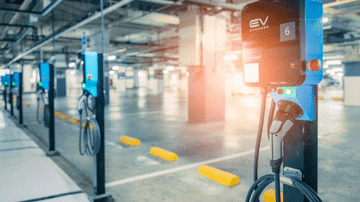Whether you’re thinking of making the switch to an electric vehicle (EV) or a plug-in electric hybrid (PHEV), or you’ve already upgraded your wheels to one of these fuel-efficient options, the fear of running out of battery midway through a drive is incredibly common. But is there actually reason to be so concerned about EV driving range?
To help you conquer your EV concerns, we’ve put together some tips on overcoming these common range issues.
How do electric vehicles work?
In order to solve the inherent range issues that people perceive to come hand in hand with all-electric vehicles, also known as battery electric vehicles (BEVs), it can help to have a basic understanding of how these vehicles work.
Unlike petrol-fuelled vehicles with an internal combustion engine, BEVs have an electric motor that’s powered by a large traction battery pack. Rather than routinely topping up your vehicle at the bowser, the battery pack of a BEV needs regular charging via a wall outlet or charging equipment, which is also known as electric vehicle supply equipment (EVSE).
Another popular choice when it comes to electric vehicles are plug-in hybrid electric vehicles (PHEVs). These vehicles combine a battery-powered electric motor with an internal combustion engine (ICE) that runs off fuel. Just like BEVs, PHEV batteries can be charged via a wall outlet, but they also come with the added bonus of collecting charge via the ICE and another process known as regenerative braking. When it comes to urban driving, most PHEVs are powered by the electric motors with the ICE kicking in only once the battery is drained, during rapid acceleration or when intense heating or cooling air conditioning is on.
The fear associated with running out of power is an incredibly common concern among people considering purchasing a BEV or PHEV, so much so that it’s been officially dubbed ‘range anxiety’. But is there really any cause for concern when it comes to taking one of these rides out for a spin?
Busting EV driving range myths
Range anxiety is a very real phenomenon and while it’s inevitable that some BEV drivers will run out of power from time to time, just as other drivers might run out of fuel, is this issue as prevalent as people think?
While petrol stations are a dime a dozen, many people still perceive public electric charging stations as few and far between. But with the rise in popularity of BEVs and PHEVs, more and more public charging stations are popping up at an increasing rate across the country and the globe.
According to the Electric Vehicle Council, when it comes to EV range, whether they be BEVs and to a lesser extent, PHEVs, there are three common misconceptions:
#1. Not enough driving range
Today’s BEVs boast an average driving range of 480kms. With the average Australian driving roughly 38kms each day, based on those figures you can assume that the majority of BEV drivers can go more than ten days without having to recharge their battery.
PHEVs on the other hand often offer an all-electric driving range of between 60-80kms, which means that most Australian drivers could go a day or two without topping up the battery while still enjoying all-electric driving before the ICE takes over.
#2. Charging takes too long
With BEV technology rapidly advancing, including electric vehicle supply equipment, the charging times are constantly reducing.
Most residential chargers take roughly six to eight hours to charge an empty battery to 100%, while rapid charging equipment can take as little as three hours to fully charge. You can even get ultra-rapid chargers that can add 300kms to your battery in ten minutes flat if you need to hit the road in a hurry. BEV charging will only get quicker as the tech continues to improve.
#3. There’s no public charging points
While most BEV owners tend to charge their vehicles at home using residential charging equipment, public charging stations are regularly being installed across the country. And with more EVs expected to hit the roads in the coming years, public charging stations will become even more commonplace, further easing the anxiety around driving range.
Tips for extending BEV range
If you’re considering making the switch to electric or you’re a proud new BEV or PHEV owner, we’ve put together our top three tips for extending the driving range of your vehicle.
1. Charge while you park
Whether you’re using your home charging station, charging equipment at the office or you have the opportunity to plug in while you’re out and about, any time your car’s parked up for an extended period can be a great time to top up the battery if you have access to charging equipment.
If you’re on the road and not familiar with the local EV charging stations, the Electric Vehicle Council has an interactive map on their website that’s constantly updated with new charging gear as it becomes available.
2. Plan your route with charging stops along the way
Are you planning a road trip but you’re anxious about running out of juice along the way? Download one of the many eDriver navigation companion apps to help guide you on your trip. These apps provide real-time updates on your range based on a number of different variables including your driving style, traffic conditions, the weather and road topography. Many of these apps also plot the locations of all the major charging stations along your route so you’re less likely to get caught out.
3. Get to know how your BEV works
Unlike traditional combustion engines that are more fuel efficient at higher speeds, EVs are more efficient at speeds less than 70km/h. Because of this, you might find you’re better off avoiding highways by taking the scenic route to get the most out of your battery. Plus, you might just be surprised at what you see when you take the scenic route.
Don’t let range anxiety hold you back from making the switch to an EV. Not only are you likely to save money on fuel and maintenance in the long run, but with the technology constantly evolving to improve the driving range and public charging stations becoming more prevalent, range anxiety will soon become a thing of the past.



